|
A guide to Mongolia religionMongolia has long been a land of varied religions, and Genghis Khan set a tradition of great religious tolerance. Mongolia religion was horrifically repressed during the communist era, but since the 1990s there has been a spiritual revival in the Mongolia. About 85% of Mongolians practice some form of Buddhism, Shamanism is practiced by a handful of ethnic minorities, and the 5% of muslim Mongolians are from Kazakh tribes in the west. Christianity now holds about 10% of the country, with foreign missionaries of various denominations all vying for influence over the Mongolian people's beliefs. I've provided a chronological overview of Mongolia religion below:
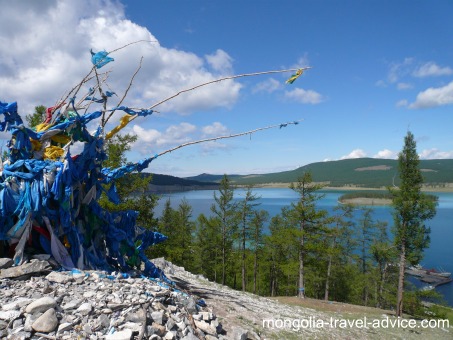
Shamanism is one of mankind's earliest religious practices, and was a widely followed religion in Mongolia. The term 'Shamanism' covers a very broad range of practices, often still undertaken by indiginous groups across Asia, Africa and the Americas. But essentially, the Shaman (religious practicioner) acts as an intermediary between the physical world and the spirit world. He enters a trance, or altered state of consciousness, by performing a seance. He can then make contact with the spirits, while witnesses will see him convulsing, talking in mystic languages, and howling like a wild beast. Spirits are often closely associated with ancestry, and the natural features. It is widely believed that Genghis Khan practiced Tengriism, a religion of northern Mongolia and Siberia which combines many elements of Shamanism with a worship of ones ancestors and 'Tengri', the lord of the blue sky. There are records of Genghis climbing significant mountains in his home region of Khenti to spend days in prayer to the spirits of the mountain and those of his ancestors. Shamanism was the dominant Mongolia religion during the great Mongol empire (i.e. 11th & 12th Century) but, over the centuries since, Shamanism and Tengriism have largely given way to Tibetan Buddhism. To speed this decline, the remaining Shamanistic practitioners (numbering only in the hundreds by the 1920s) were ruthlessly persecuted by the Communist regime. The Tsataan (or 'Reindeer') people near Lake Khovsgol now represent one of the few peoples still practising these ancient rituals. Jasper Becker's fantastic book, The Lost Country provides an account of these rituals being performed by the Tsaatan in the early 1990s; at the time these people were struggling to recount these old traditions after half a century of communist repression of Mongolia religion, but since then there have been concerted efforts to revive these ancient practices. While Shamanism is practiced as a religion in Mongolia by only a select few, many elements of it have found their way into more modern religions. Many Mongolians from all religions hold a special worship for the blue sky, and Buddhist prayers and offerings are often made at Ovoos (shamastic cairns of stones) to the spirits of proximate mountians and rivers. 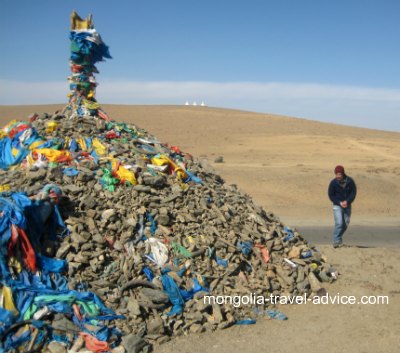
During the time of Genghis Khan, the most common Mongolia religion was Shamanism. As stated, Genghis Khan was very likely a follower of Shamanism/Tengriism, but by the 11th century virtually every religion -from Buddhism, to Islam, to Christianity- had representative followers on the Mongolian steppe. Most empires up to the middle ages and beyond were based on a common religious identity. In a radical (and quite modern!) departure from this tradition, Genghis Khan based his empire on allegiance, not religion, and decreed universal religious freedom throughout his empire. Genghis maintained his own beliefs but recognised the positive elements in different Mongolia religions. He invited Buddhist, Christian, and Muslim leaders to his court, to share their ideas and answer his questions. This tradition grew after Genghis' death and was carried on by other Khans. A French missionary, William of Rubruck, wrote a rare and often-related account of visiting the Court of Genghis' grandson, Mongke Khan, at Karakorum for a religious debate: [The Khan] sent his secretaries to me, who said: "Our lord sends us to you to say that you are here Christians, Saracens [i.e. Muslims] and Buddhists. And each of you says that his doctrine is the best, and his writings the truest. So he wishes that you shall all meet together...and make a comparison so that he himself may be able to know the truth."...And there was a great concourse of people there; for each side had called thither the most learned of its people, and many others had also assembled. Mongke insisted each Mongolia religion be given a fair hearing in his court; Rubruck continues: We were assembled...and Mongke Khan sent three secretaries who were to be umpires, one a Christian, one a Saracen, and one a Buddhist; and it was published aloud: "This is the order of Mongke, and let no one dare say that the commandment of God differs from it. And he orders that no one shall dare wrangle or insult any other, or make any noise by which this business shall be interfered with, on penalty of his head." Rubruck in his Christian piety was far more prejudiced against competing religions in Mongolia than the supposedly 'barbaric' Mongols (he almost got in a fight with a bunch of Muslim "dogs" outside the Khan's court). He relates his dissappointment at his own performance in the debate, and was soon thereafter told by Monge that he should head on back home. When considering the current day efforts of competing religions to win the hearts, minds and souls of Mongolians, it's worth contextualizing events within this long history of openness to religion in Mongolia. Those Mormons or Korean mssionaries you bump into are -if nothing else- nothing new to Mongolia religion. Back to Top 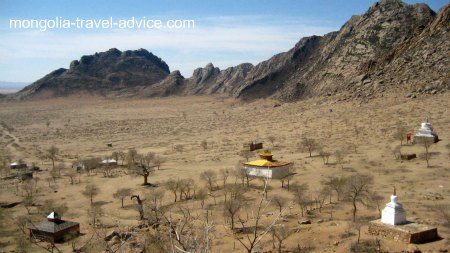
Ghenghis Khan's other grandson, Kubilai, ruled over the Mongol empire at it's greatest point. During his rule, he entertained numerous religious debates in his court in Beijing, but fell increasingly under the influence of Fagpa, a powerful Tibetan lama. Some say Kubilai actually converted to Buddhism, but in any case this period marked the beginning of the Buddhism's ascendancy over other Mongolia religions. From the 12th Century, the Mongol empire fragmented and weakened due to rifts amongst potential heirs to the throne. The Chinese saw the opportunity in their weakness and soon chased the Mongols back across the Gobi and to the Mongolian steppe. The Manchus of the Qing dynasty soon gained loose but brutal control of modern-day Mongolia, taxing the Mongols while allowing them to plunge back into the clan warfare of pre-Genghis times. During these dark times and lack of any political hegemony amongst the warring Mongolia tribes, Buddhism played an increasingly important role -soon becoming Mongolia's most influential institution. 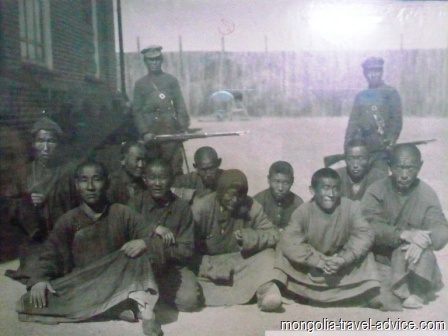
The Buddhist Church vied for influence with traditional Shamanists and increasingly gained ground as the most popular religion in Mongolia. Buddhist lamas (i.e. Monks) steadily control of the country and constructed monasteries everywhere (about 600-700 existed when the communists came to power). About 20% of the country's males became lamas, and it was common in parts of Mongolia for each family to give their first son to the monasteries. By the 1600s Buddhism was a strong political institution; the great lama Zanabazar allied himself with the Manchus and commanded his own armies against warring Mongol tribes in the west. By the 1920s, 90% of Mongolians were Buddhist, the country's biggest city (Ulan Bator) was based around a tent monastery, the Clergy was richer than the State, and the highest spiritual leader in the country, the Bogd Khan, was also the country's political leader. The Buddhist religious hierarchy soon became interlinked with the Mongolian tribal nobility, and foreign observers noted the corruption, greed, and immorality of some of the Buddhist clergy. Generally the Mongolians seemed to forgive these indiscretions, and remained very loyal to the Buddhist church. Back to Top 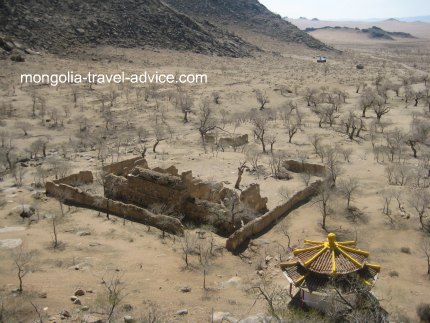
Mongolia saw some of the most brutal supression of religion in the entire Soviet union. Religion is of course antithetical to Socialist ideology, but Buddhism's prominent political and economic role in Mongolia made it a threat to Communism that had to be viciously destroyed. During the 1930s, a number of purges took place. Nobody really knows, but anywhere from 35,000 to 100,000 Mongolians were killed and put in mass graves all around the country. The executions focused on the Buddhists lamas above all others. For each person killed, another was sent to forced labour camps in Siberia. 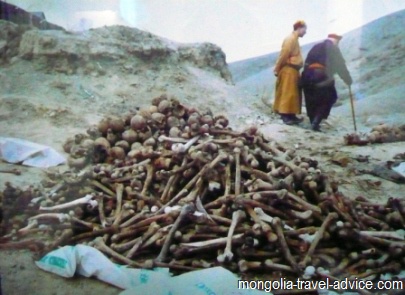
When the communists took power, an anti-Buddhist league was set up by the Government, and mobs roamed the country destroying Monasteries, statues, and anything to to with Mongolia religion. Outraged lamas incited a violent uprising in 1932, and gained the popular support of other Mongolians. A popular insurrection began, but the Russians sent special forces troops in, and the Mongolians were no match for the guns, tanks and aeroplanes of the Russians. Stalin himself heard of the uprising and insisted to the contemporary Mongolian president, Genden, that the lamas be 'liquidated'. Like most Mongolians, Genden had sympathies with the lamas and refused his requests repeatedly. Due to this insubordination in support of Mongolia religion, he was sent to Moscow and shot. Stalin found a willing stooge in Khorloogiin Choibalsan, an alcoholic Mongolian with a weak character who was groomed by Soviet intelligence. Choibalsan was swiftly promoted within the Mongolian communist party, with anybody standing in his way being mysteriously klled; he assumed the presidency within a within a few short years. He was sent to Moscow and intructed by Stalin to kill the lamas; Choibalsan obeyed. 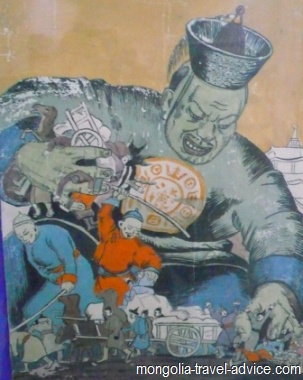
Death squads led by Soviet intelligence officers roamed the countryside. Monasteries were destroyed with explosives, often razed to the ground. Of 700 or so in the country, only a few remained standing. Books were burned in piles, Some lamas attempted to sequester sacred texts in caves, but almost all were completely destroyed. The lamas had accrued huge wealth over the last 600 years, and the Communists quickly plundered it. Thousands of gold statues were taken in trucks as 'gifts' to be melted down in Moscow. Of the monks and lamas themselves, over 20,000 were executed. Some were tortured and castrated. Those who attempted to flee in the mountains were eventually hunted down, and any Mongolians attempting to harbor or feed the lamas were themselves executed. 600 years of Mongolia religion was almost completely erradicated in a short number of months. Over the years that followed, this repression was further consolidated by secret police and informants who roamed the country. Being caught with a Buddhist altar in a yurt, praying at an ovoo, hiding a religious text, or using Buddhist herbal medicine would lead to imprisonment or execution. These draconic laws against Mongolia religion were only relaxed in the 1980s, but the damage had been done. [For further information on this horrible period in Mongolia's history, read Jasper Becker's The Lost Country or visit the Political persecution museum in Ulan Bator. 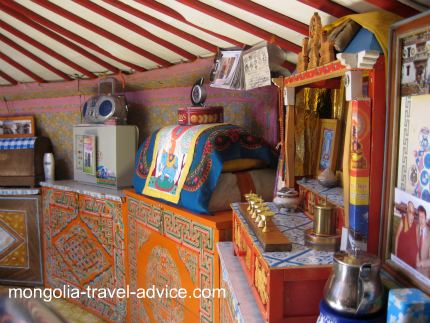
Despite the brutal suppression of Mongolia religion by the communist police state, Mongolians risked their lives throughtout the communist years to clandestinely practice thier religious beliefs. Individuals prayed, and secret gatherings took place at night to perform Buddhist and Shamanistic rituals. With the fall of Communism in the 1990s, religion has experienced a resurgence. Those few monasteries left standing -which had stood empty for 60 years- are now steadily filling with young monks. Communities are trying to recall their religious practises, and teach the young those rights and rituals which had previously been forbidden. The post-Communist years have seen a huge amount of change in Mongolia -mostly positive, but still destablizing- and poverty and alcohol abuse continue to take their toll: Mongolia religion offers a comforting spritual constant against the troubling changes of the outside world.Today, travelers visiting yurts will see statues or prints of the (many) gods from the Tibetan Buddhist pantheon sitting on an altar surrounded by incense, and perhaps a photo of the Dalai Lama. The Mongols will pray to these. Visitors will also see many Ovoos, shamanistic cairns of stones or piles of wood, often atop mountains. Mongolians will visit Ovoos, add a couple of stones to the pile, and leave a small offering of tea, vodka, cigarrettes, or an animal skull. Mongolians may also give a blue prayer scarf, an offering to the lord of the blue sky. If driving past and in a rush, you might see your driver honk his horn instead, which ensures a blessing for the hurried! You will see Mongolians walk around an ovoo 3 times in a clockwise direction, and make an offering to ensure a safe journey. Also, they will always walk within a ger or around a monastery in a clockwise direction, as this is a sign of Buddhist respect and veneration. Back to Top 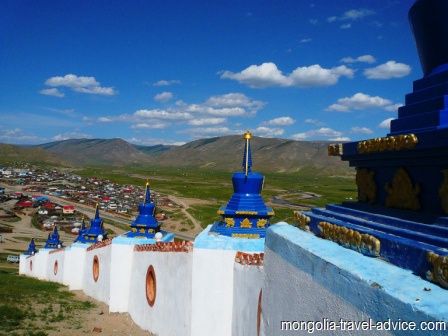
These days, many Western churches are pouring money and missionaries into Mongolia religion, providing increasing and well-financed competition to Mongolian Buddhism. There seem to be a particularly large number of Korean missionaries around the place; they are nice enough, and they even offer prayers for you if you cut your finger! The Church of Latter Day Saints (Mormons) have numerous churches, and over 100 missionaries, in Mongolia. As one of the Mormon websites states: Personally, I don't follow any religion, but I do follow history, and it's apparent to me that over the millenia religious competition has created a huge amount of human suffering, and missionary crusades to 'civilize' and enlighten other peoples have been anything but enlightened. But, before I go and say that these missionaries pouring in are downright scary, I remind myself that this is indeed the 21st century, and times really have changed. Different religions in Mongolia were tolerated from the days of Genghis Khan. Mongolia has traditionally been a religiously tolerant place, and so it should continue to be. As Buddhists competed with Shamanists 400 years ago, they now must contend with Christians: so let the competition in Mongolia religion continue. In terms of positives, many missionaries are doing great charity work, helping Mongolian communities and saving lives. They are also educating Mongolians; this no doubt includes Bible classes, but it is still very much furthering the local population. My fiancee met a Mongolian who held an American college degree, he told her a church in the States had funded the entire thing. She asked if he was still deeply religious, he replied, "not really, we just pretend we believe this stuff so we can get an education." Mongolian ingenuity at its best!!
|